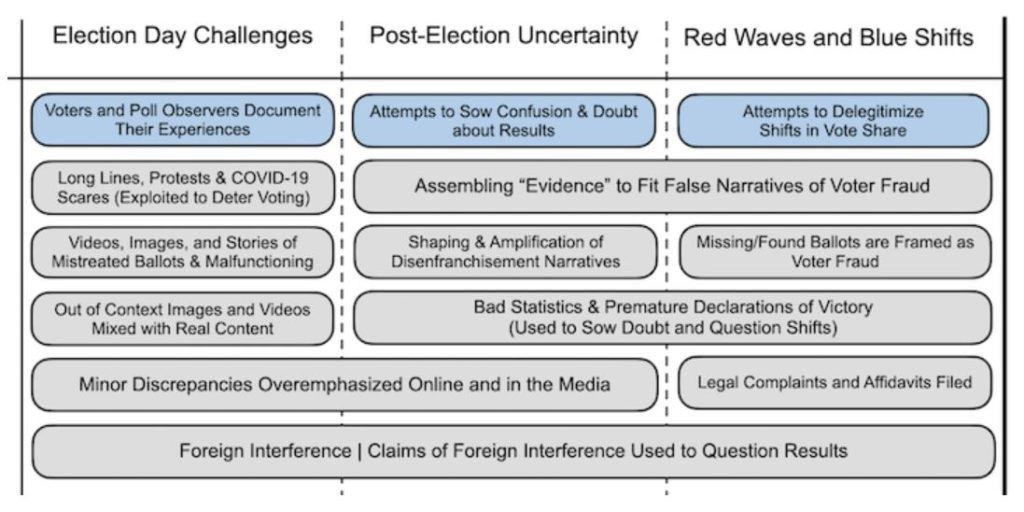By Adam Tomasi
On Friday, December 11, 2020, the NULab hosted a virtual panel, “What do the data tell us about election 2020?” The panel consisted of four speakers with expertise in political advertising and communication, online disinformation, and election history. The invited guests were Dr. Erika Franklin Fowler, Professor of Government at Wesleyan University and director of the Wesleyan Media Project; Solomon Messing, Chief Scientist at Lockwood Strategy (ACRONYM) and an affiliated researcher at Georgetown University; Dr. Kate Starbird, associate professor at the Department of Human Centered Design & Engineering at the University of Washington; and Dr. Jill Lepore, the David Woods Kemper ‘41 Professor of American History and Affiliate Professor of Law at Harvard University. The panelists were introduced by David Lazer, co-director of the NULab and Distinguished Professor of Political Science and Computer and Information Science at Northeastern University. He opened with the observations that the “information ecosystem” was highly influential in the 2020 election, and that a sufficient length of time had passed that researchers could observe the effects of that information ecosystem after November 3.

Erika Franklin Fowler’s presentation, “Trends in 2020 Political Advertising,” summarized the data on the “general election advertising breakdown” that she and a student team at the Wesleyan Media Project collected and coded. WMP looked at “ad volume” and discovered that Trump’s early on-air advantage dissipated by the Fall, when Biden pulled ahead. Campaign spending on Google advertisements was comparable to spending on Facebook advertisements, and record-breaking spending levels in Congressional races favored Democratic candidates. Fowler also found that the tone of the advertising from the Biden and Trump campaigns was less negative overall than in 2016. She measured tone according to the balance of “attack ads” and “contrast ads” relative to advertisements focused more on self-promotion. Trends varied by circumstance; the Biden campaign ran fewer negative advertisements while Trump had COVID-19, and the Trump campaign ran more negative ads in the last weeks of the election. Lastly, Fowler observed that compared to the 2018 midterm elections in which healthcare was the top issue, the 2020 election had a greater variety of issues at play.
Solomon Messing’s presentation, “What happened in 2020? A view from inside the progressive Left,” covered his work for ACRONYM and its Barometer project on “expanding the electorate” with online advertising. Messing was particularly interested in “behavioral correlates of persuasion,” and found that ACRONYM’s sponsored Facebook advertisements, otherwise known as “boosted news,” were effective at swaying centrist and conservative voters against Trump. Boosted news of conservative messengers criticizing Trump was most effective at reaching the centrist voters that Messing and his team determined from a voter file. To measure the behavioral correlates of persuasion connected to these ads, Messing found that the ratio of “haha” and sad reactions on the advertisements was the strongest signal of Trump disapproval. He also concluded that “the right-wing media machine was more effective than in-cycle campaign spending” in the 2020 election.
Kate Starbird’s presentation, “Participatory Disinformation and Election 2020,” examined the viral false narratives of voter fraud circulated by Trump, his campaign operatives, and other social media influencers before and after November 3rd. She drew a distinction between misinformation, or false information that is not necessarily intentional, and disinformation, which is purposely misleading for the sake of a financial or political objective. With the Election Integrity Partnership, Starbird and colleagues published a report on October 26, 2020 that told voters what sorts of misinformation and disinformation they could expect to see during and after Election Day. False narratives of voter fraud—such as the assertions of widespread fraud from mail-in ballots, ballots allegedly thrown away or carted in suitcases, and “Sharpiegate”—were shared by “disinformation influencers” to spread doubts of the legitimacy of the election results. Starbird concluded that the extent these deceitful stories were retweeted suggests that “disinformation is participatory,” although it is surely connected with top-down efforts from elites. She also emphasized that disinformation spreading throughout a democratic society will chip away at its very foundations.
Jill Lepore’s presentation interrogated the historical origins of the “cultural role of data reporting in elections” in the United States. In 1952, CBS News used the UNIVAC computer to predict the presidential election from early results. In 1955, science fiction writer Isaac Asimov wrote “Franchise,” the story of a “Multivac” computer that could predict the election with ‘perfect’ data based upon one representative American voter. Although the Multivac has not become reality, data-driven message testing became a feature of campaigns by 1959, when the Democratic National Committee hired the Simulmatics Corporation to assist the Kennedy campaign by “predicting voter types” (alluding to her most recent book, If Then: How the Simulmatics Corporation Invented the Future, 2020). Lepore compared this recent history to the turn of the twentieth century, when voters made “amateur predictions” of elections after crowding around newspaper offices or closely following the radio. Replacing this active participation was a computer-driven process that alongside starkly-divided electoral maps has brought “passivity” and “anguish” to voters. Lepore concluded that “a lot more public activity would take away the perception that the election is a fraudulent simulation.”
The event had a vibrant Q&A not only because of a sizable turnout, but also because some of the attendees were specialists on election data in their own right. During the Q&A, Lazer agreed with an observation from Dr. Starbird that overlapping networks were responsible for online misinformation on COVID and political disinformation about the election. Lazer referenced results that he and other researchers found after collecting national survey data, that users of WhatsApp and Facebook Messenger were more susceptible to misinformation about COVID-19, and that Democrats and Republicans were growing more divided since the Spring on COVID-19 guidelines including mask mandates. The NULab is looking forward to more robust discourse in the Spring with upcoming panels.



